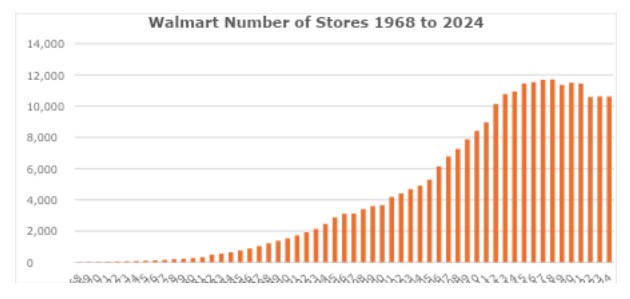Walmart's Transformative Ways Spark a 100,000% Stock Return
Walmart's strategic store expansion and relentless cost-cutting have catapulted its share price over the years.


Editor's note: This is part 12 of a 13-part series about companies whose shares have amassed 100,000% returns for investors and the path taken to generate such impressive gains over the long term. See below for links to the other stocks in this series.
From its humble beginnings as a small discount store in Rogers, Arkansas, Walmart (WMT) has grown into a global retail powerhouse, transforming the way the world shops.
How did a single store become the largest retailer in the world, with over $600 billion in annual revenue? The answer lies in Walmart's unique approach to expansion and its relentless focus on cost control.

Sign up for Kiplinger’s Free E-Newsletters
Profit and prosper with the best of expert advice on investing, taxes, retirement, personal finance and more - straight to your e-mail.
Profit and prosper with the best of expert advice - straight to your e-mail.
By strategically opening thousands of stores and mastering supply chain management, Walmart has consistently outperformed its competitors and reshaped the retail landscape.
To truly understand Walmart's success, we must examine these key areas: its aggressive store expansion and improvements in gross margins through cost-effective procurement. Together, these factors reveal the secrets behind Walmart's sustained growth and its ability to dominate the global market.
A major driver of Walmart's growth has been its aggressive expansion strategy. In 2000, Walmart operated 3,662 stores worldwide including Supercenters, discount stores, and Sam's Clubs.
By 2023, the number of stores had grown to 10,130. This rapid expansion allowed Walmart to capture a broad customer base across both urban and rural areas.

Looking at sales per store over time provides insights into Walmart's growth strategy.
In 2000, Walmart reported a revenue of approximately $167 billion. Dividing this by its 3,662 stores results in an average sales per store of around $45.6 million.
By 2023, Walmart's revenue had surged to nearly $611 billion. With over 10,623 stores, the average sales per store had risen to approximately $57.5 million. Over time, Walmart's methods allowed it to increase the productivity of each store by 26%.
Improving and maintaining gross margins has also been crucial to Walmart's ability to offer low prices and sustain profitability.
Walmart's massive scale allows it to negotiate better prices with suppliers, driving down the cost of goods sold and enhancing/maintaining gross margins. For a decade, Walmart has been able to keep its gross margin in the range of 24% to 26%.
You could almost say that Walmart is impervious to inflation, and that's one reason shoppers come back to Walmart again and again.
Amazingly, during the peak inflation of 2022, when the rate in the U.S. peaked at 9.1%, Walmart was able to maintain its gross margin at 24.1% that year, only 4% lower than the previous year's gross margin of 25.1%.
And when inflation abated in 2023, Walmart's gross margin was able to bounce back to 26.2%.
The company has leveraged its buying power to source goods at lower prices and invested in technology to enhance inventory management. These efforts have allowed Walmart to reduce the cost of goods sold and maintain its "Everyday Low Price" strategy, attracting price-sensitive customers and driving sales volume.
Despite economic fluctuations and changing market conditions, Walmart's ability to adapt and leverage its massive scale has enabled it to thrive.
As the largest retailer in the world, Walmart continues to shape the retail industry, demonstrating that a well-executed growth strategy and a relentless focus on cost control works.
The formula is still valid, and Walmart likely has more growth to deliver to shareholders.
Note: This content first appeared in Louis Navellier's latest book, The Sacred Truths of Investing: Finding Growth Stocks that Will Make You Rich, which was published by John Wiley & Sons, Inc.
Other 100,000% return stocks
- McDonald's Stock: How Small Changes Have Led to 100,000% Returns
- How Amazon Stock Became a Member of the 100,000% Return Club
- M&A Is Why UnitedHealth Group Stock Is a Member of the 100,000% Return Club
- Sherwin-Williams Is a Sleeper of the 100,000% Return Club
- Dealmaking Drives HEICO Stock's 100,000% Return
- Adobe Stock's Path to a 100,000% Return Is Impressive
- Apple's 100,000% Return Is a Result of Innovation, Brand Loyalty and Buybacks
- Home Depot's Winning Ways Fueled Its 100,000% Return
- It's No Surprise That Berkshire Hathaway's in the 100,000% Return Club
- Nvidia Stock's Been Growing for Years. Just Look At Its 100,000% Return
- Relentless Leadership Drives Oracle Stock's 100,000% Return
Get Kiplinger Today newsletter — free
Profit and prosper with the best of Kiplinger's advice on investing, taxes, retirement, personal finance and much more. Delivered daily. Enter your email in the box and click Sign Me Up.

-
 The AI Doctor Coming to Read Your Test Results
The AI Doctor Coming to Read Your Test ResultsThe Kiplinger Letter There’s big opportunity for AI tools that analyze CAT scans, MRIs and other medical images. But there are also big challenges that human clinicians and tech companies will have to overcome.
By John Miley Published
-
 The Best Places for LGBTQ People to Retire Abroad
The Best Places for LGBTQ People to Retire AbroadLGBTQ people can safely retire abroad, but they must know a country’s laws and level of support — going beyond the usual retirement considerations.
By Drew Limsky Published
-
 Financial Planning's Paradox: Balancing Riches and True Wealth
Financial Planning's Paradox: Balancing Riches and True WealthWhile enough money is important for financial security, it does not guarantee fulfillment. How can retirees and financial advisers keep their eye on the ball?
By Richard P. Himmer, PhD Published
-
 A Confident Retirement Starts With These Four Strategies
A Confident Retirement Starts With These Four StrategiesWork your way around income gaps, tax gaffes and Social Security insecurity with some thoughtful planning and analysis.
By Nick Bare, CFP® Published
-
 Should You Still Wait Until 70 to Claim Social Security?
Should You Still Wait Until 70 to Claim Social Security?Delaying Social Security until age 70 will increase your benefits. But with shortages ahead, and talk of cuts, is there a case for claiming sooner?
By Evan T. Beach, CFP®, AWMA® Published
-
 Retirement Planning for Couples: How to Plan to Be So Happy Together
Retirement Planning for Couples: How to Plan to Be So Happy TogetherPlanning for retirement as a couple is a team sport that takes open communication, thoughtful planning and a solid financial strategy.
By Andrew Rosen, CFP®, CEP Published
-
 Market Turmoil: What History Tells Us About Current Volatility
Market Turmoil: What History Tells Us About Current VolatilityThis up-and-down uncertainty is nerve-racking, but a look back at previous downturns shows that the markets are resilient. Here's how to ride out the turmoil.
By Michael Aloi, CFP® Published
-
 Stock Market Today: Stocks Surge to Close a Volatile Week
Stock Market Today: Stocks Surge to Close a Volatile WeekIt was another day with a week's worth of both news and price action, but it ended on a strongly positive note.
By David Dittman Published
-
 Home Insurance: How to Cut Costs Without Losing Coverage
Home Insurance: How to Cut Costs Without Losing CoverageNatural disasters are causing home insurance premiums to soar, but don't risk dropping your coverage completely when there are ways to keep costs down.
By Jared Elson, Investment Adviser Published
-
 Markets Roller Coaster: Resist the Urge to Make Big Changes
Markets Roller Coaster: Resist the Urge to Make Big ChangesYou could do more harm than good if you react emotionally to volatility. Instead, consider tax-loss harvesting, Roth conversions and how to plan for next time.
By Frank J. Legan Published